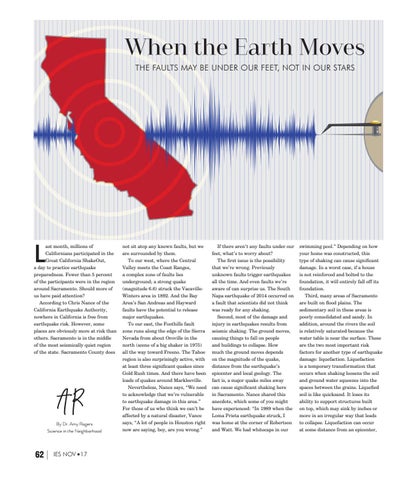When the Earth Moves THE FAULTS MAY BE UNDER OUR FEET, NOT IN OUR STARS
L
ast month, millions of Californians participated in the Great California ShakeOut, a day to practice earthquake preparedness. Fewer than 5 percent of the participants were in the region around Sacramento. Should more of us have paid attention? According to Chris Nance of the California Earthquake Authority, nowhere in California is free from earthquake risk. However, some places are obviously more at risk than others. Sacramento is in the middle of the most seismically quiet region of the state. Sacramento County does
AR By Dr. Amy Rogers Science in the Neighborhood
62
IES NOV n 17
not sit atop any known faults, but we are surrounded by them. To our west, where the Central Valley meets the Coast Ranges, a complex zone of faults lies underground; a strong quake (magnitude 6.6) struck the VacavilleWinters area in 1892. And the Bay Area’s San Andreas and Hayward faults have the potential to release major earthquakes. To our east, the Foothills fault zone runs along the edge of the Sierra Nevada from about Oroville in the north (scene of a big shaker in 1975) all the way toward Fresno. The Tahoe region is also surprisingly active, with at least three significant quakes since Gold Rush times. And there have been loads of quakes around Markleeville. Nevertheless, Nance says, “We need to acknowledge that we’re vulnerable to earthquake damage in this area.” For those of us who think we can’t be affected by a natural disaster, Vance says, “A lot of people in Houston right now are saying, boy, are you wrong.”
If there aren’t any faults under our feet, what’s to worry about? The first issue is the possibility that we’re wrong. Previously unknown faults trigger earthquakes all the time. And even faults we’re aware of can surprise us. The South Napa earthquake of 2014 occurred on a fault that scientists did not think was ready for any shaking. Second, most of the damage and injury in earthquakes results from seismic shaking. The ground moves, causing things to fall on people and buildings to collapse. How much the ground moves depends on the magnitude of the quake, distance from the earthquake’s epicenter and local geology. The fact is, a major quake miles away can cause significant shaking here in Sacramento. Nance shared this anecdote, which some of you might have experienced: “In 1989 when the Loma Prieta earthquake struck, I was home at the corner of Robertson and Watt. We had whitecaps in our
swimming pool.” Depending on how your home was constructed, this type of shaking can cause significant damage. In a worst case, if a house is not reinforced and bolted to the foundation, it will entirely fall off its foundation. Third, many areas of Sacramento are built on flood plains. The sedimentary soil in these areas is poorly consolidated and sandy. In addition, around the rivers the soil is relatively saturated because the water table is near the surface. These are the two most important risk factors for another type of earthquake damage: liquefaction. Liquefaction is a temporary transformation that occurs when shaking loosens the soil and ground water squeezes into the spaces between the grains. Liquefied soil is like quicksand. It loses its ability to support structures built on top, which may sink by inches or more in an irregular way that leads to collapse. Liquefaction can occur at some distance from an epicenter,
